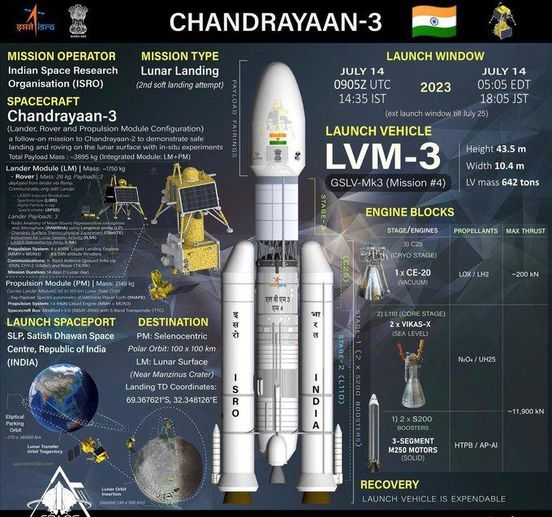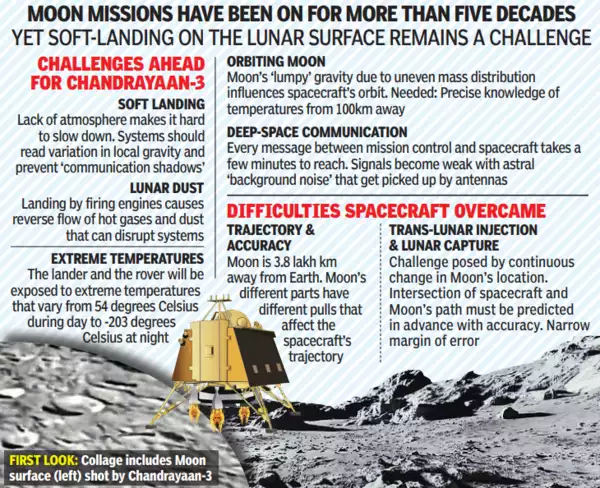Chandrayaan 3 Introduction:
Chandrayaan 3 is a remarkable testimony to India’s scientific prowess and space exploration efforts. This ambitious mission launched by the Indian Space Research Organization (ISRO) aims to advance our understanding of the Moon’s surface and its unknown regions. Building on the successes of its predecessors, Chandrayaan 1 and Chandrayaan 2, the Indian Space Research Organization (ISRO) Organization (ISRO) is all set to start a new chapter in lunar exploration with Chandrayaan 3. The mission’s complex design, scientific objectives and remarkable achievements made Chandrayaan-3 target the Moon’s south pole, a region of water ice or frozen water that could provide oxygen, fuel and water

Scientific Objective:
The main objective of Chandrayaan-3 is soft landing on the south pole of the moon. This achievement makes India among the countries in the world that have attempted soft lending.
Amazing Scientific Treasure of Moon:
Through Chandrayaan-3, India will get a chance to touch the amazing eleven day line and night line of the Moon. This line will help scientists understand the Moon’s annual day-night cycle.
Scientific Ganga-Yamuna Mixture:
One of the main achievement of Chandrayaan-3 is that it will search for water in richness on the surface of South Pole region. Scientists are trying to confirm the existence of water on the Moon, similar to oceans, and this will enrich their picture of how these water sources can be found in the polar regions of the Moon.
Important Dates of the Mission:
On August 23, the Sun will rise over the South Pole, providing suitable user days for Chandrayaan-3’s landing. This will increase the chances of success in landing.

In the run up to the mission, Chandrayaan-3’s lander and rover are aimed at making a historic soft landing on the South Pole of the Moon. This effort has marked India’s emergence in the elite class that has made a successful soft landing at the South Pole, making India the only country with this distinction.
One day on the Moon is approximately equal to 14 days on Earth. The landing of Chandrayaan-3 is going to happen on August 23 because from this day the sunlight is going to emerge on the south pole of the Moon. This will give the lander and rover an opportunity to do research on the lunar surface.
There is a scientific reason behind the Moon being sent to the polar regions. Geologists here believe that sunlight never reaches this area and the temperature here can go very low, due to which the presence of water in the form of ice is possible in this area.
After the landing of Chandrayaan-3, the scientific research of the lander and rover will begin. This journey will be completed in about 40 days and after that the lander of Chandrayaan-3 will reach the lunar surface.
The landing of Chandrayaan-3 is very important from a technical point of view. Three phases will be used for landing – the rough braking phase, the attitude hold phase and the fine braking phase. These stages are designed to safely deliver the lander to the lunar surface.
Chandrayaan 3 designer name
Aerospace engineer Shridhar Panicker Somnath or S. Somnath was involved in the design of Chandrayaan 3 and was instrumental in designing the Chandrayaan 3 rocket, the launch vehicle Mark-III or Bahubali rocket, which could propel Chandrayaan-3 into its intended orbit. Before the Chandrayaan 3 mission, Somnath was part of several missions conducted by ISRO. P Veeramuthuvel was the director of Chandrayaan-3.
Rough Braking Phase:
This phase will bring the horizontal velocity down to half the height of 30 km above the Moon’s surface.
Attitude Hold Phase: The lander will move from horizontal to vertical at an altitude of 7.42 km and prepare for the fine braking phase.
Increased Braking Phase:
This phase will help the Lander to land on the surface of the South Pole.
The lander will be stable on the lunar surface after this phase and its rover will be charged.
With Chandrayaan-3 successfully in process, India will once again establish that it can play a leading role in scientific research, and succeed in opening new doors on the lunar surface. This effort is not only scientifically significant, but it is also an inspiration for generations to come who dream of pursuing their careers in the fields of Science, Technology, Engineering and Mathematics (STEM).
ending:
The candidature of Chandrayaan-3 has taken India a significant step forward in solar system astronomy. The scientific and technological prowess emanating from this mission will emerge as a testimony to the highest standards of the Indian Space Organization (ISRO). The achievements of Chandrayaan-3 will be helpful in promoting not only science but also self-confidence and it can be a sign of a new beginning, which will inspire the coming generations towards science and space.



